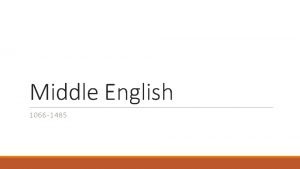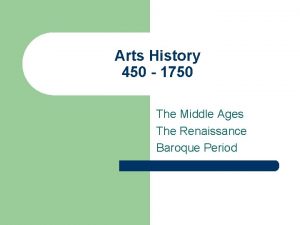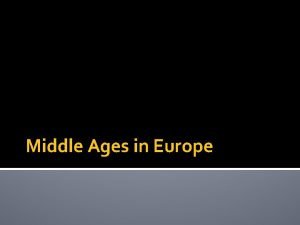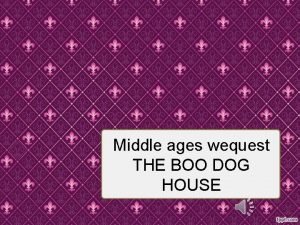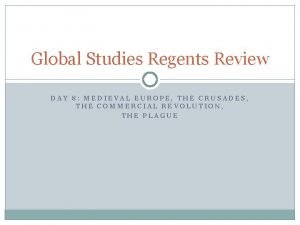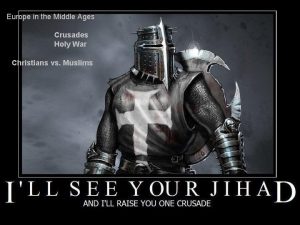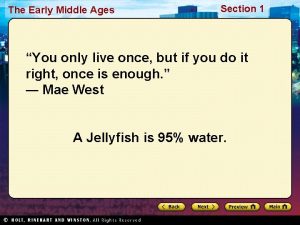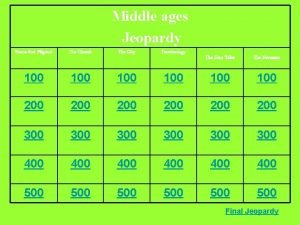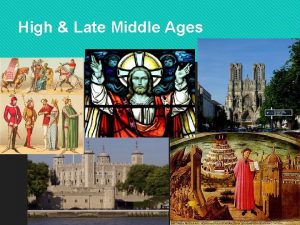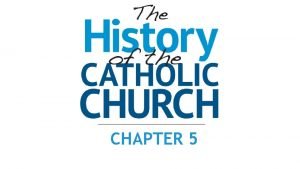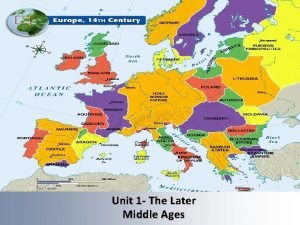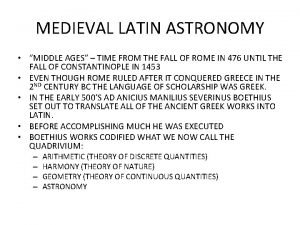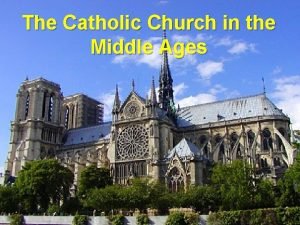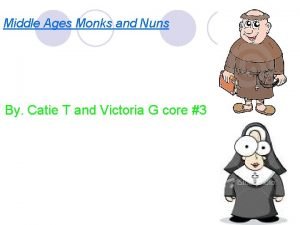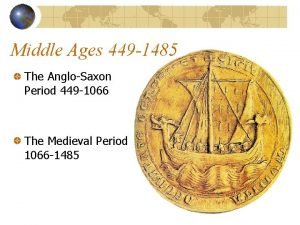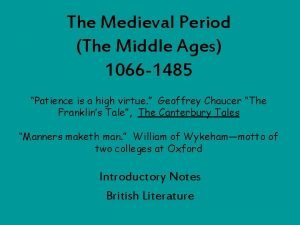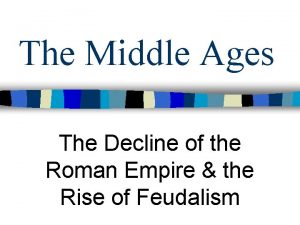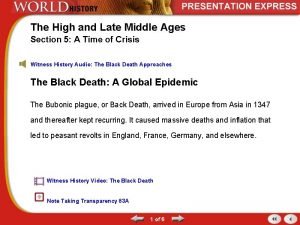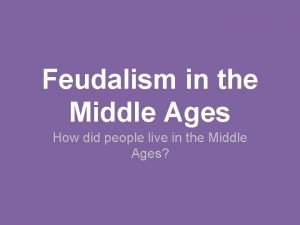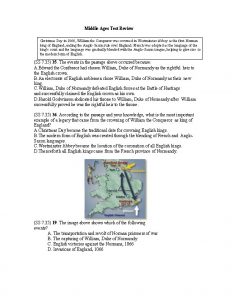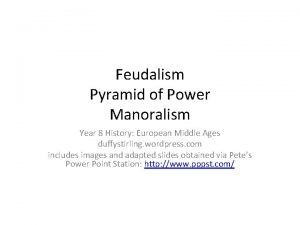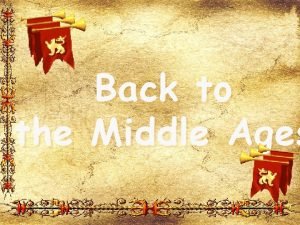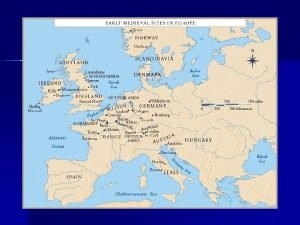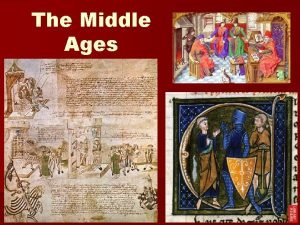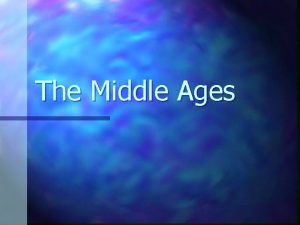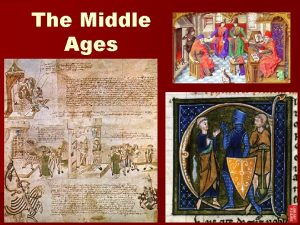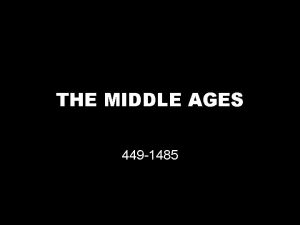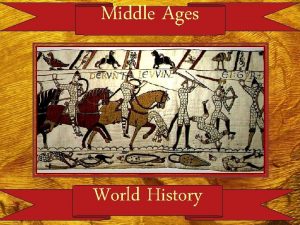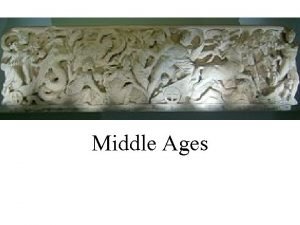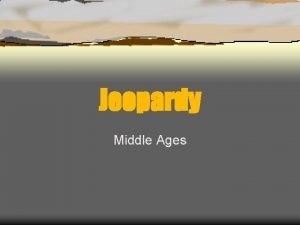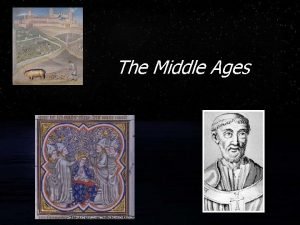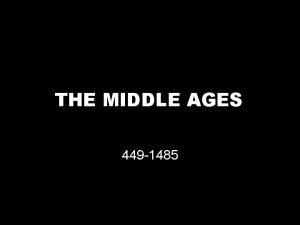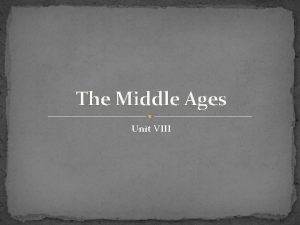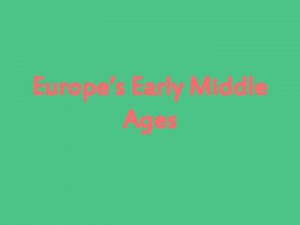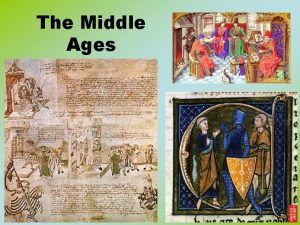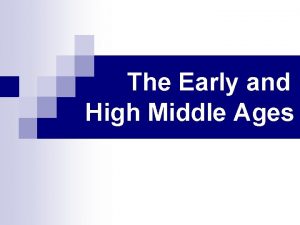The Middle Ages FMajor Events The Middle Ages






























- Slides: 30

The Middle Ages

FMajor Events: The Middle Ages F 476 ce - Destruction of Western Roman Empire F 500 -1000 Creation of Feudal Kingdoms F 700 -800 s Rise of powerful Kings (Clovis, Charles Martel, Charlemagne) F 800 s - Viking Invasions of Europe F 11 th Century - Christian Crusades F 1054 - Great Schism of Christianity FMid-14 th Century The Bubonic Plague “Black Death” strikes western Europe F 13 th-15 th Centuries Rise of Nation-States of Europe

The Middle Ages FAfter the fall of Rome, Europe was in a state of chaos with no government FAlso known as the Medieval Period or the Dark Ages because of the lack of development (trade, education, gov’t reform, life expectancy). FLasted from about 500 to 1000 CE in Europe FTrade slowed, towns emptied, learning slowed

The Middle Ages FThree Main Groups: FThose Who Work - Feudalism FThose Who Pray - Catholic Church FThose Who Fight - Kings, Knights, The Crusades

Those Who Work: Feudalism F Gov’t organized to protect territories from invaders Kings & Nobles Merchants & Soldiers Peasants/Serfs

Feudalism/Manorialism F People left cities to live on manors (the lord’s estate) in order to grow food to live F Self-sufficient communities where people produced everything they needed F Feudalism: social/economic/political system F Manorialism: Self-sufficient manors [3 -field system] -Peasants paid taxes on milling grains, marriages, rents -Serfs: could not leave without permission; treated like slaves; children born into serfdom

Feudalism FPeople left cities to live on manors (the lord’s estate) in order to grow food to live FSelf-sufficient communities where people produced everything they needed

Feudalism FPeasants paid taxes on milling grains, marriages, rents FSerfs: could not leave without permission; treated like slaves; children born into serfdom

Those Who Pray - The Catholic Church The Church provided charity: food, shelter, clothing to poor, orphans FMonasteries - become centers for learning; Monks know how to read and write FIlluminated Manuscripts - handwritten copies of religious documents


Catholic Church organization Cardinals Archbishops Bishops Priests

The Catholic Church FForced people to pay tithes to the Church FCould excommunicate members or kick them out of the church FSold indulgences, simony FKings and Nobles could appoint church officials Indulgenceforgiveness for sins Simony- buy church job

FMostly religious based FDark FOverly ornate FGothic - Late Middle Ages Medieval Art

Gothic Architecture

The Middle Ages: By Period Early Middle Ages: 500 – 1000 -Rise of the Franks [Merovingians/Clovis I/Charlemagne] -Monks/Monasteries preserve knowledge High Middle Ages: 1000 – 1250 -Increased Catholic Church Power -Ongoing battles against Muslims in Spain (began in 8 th century) Late Middle Ages: 1250 – 1450 -Resurgence of learning and inventions lead to Renaissance -Increased Catholic Church power leads to Reformation -Regional Kingdoms gain power leading to increased trade routes and Exploration

The High Middle Ages - Those Who Fight Lasted from 1100 to 1300 CE; during this period, Europe developed nation-states with populations and a national unity: FNations led by kings, princes as rulers FMade war against others to obtain territory FTrade rose and towns developed FCatholic Church led wars for Christian domination

Rise of Nation-States FEngland FFrance FHoly Roman Empire FSpain

The Crusades Holy wars to regain Jerusalem from the Muslims; first called by Pope Urban II who promised: FForgiveness for sins FCancellation of debts FProtection for families and property FCancellation of criminal charges FLand wealth (from the Turks)

1 st Crusade: 3 groups marched to Holy Land FMost successful; Crusaders captured Jerusalem & Antioch; massacred thousands of Muslims FProblems: heat, supplies, disunity The Crusades

The Crusades F 2 nd Crusade: Muslims retake Jerusalem; group sent to take the city was defeated F 3 rd Crusade (King’s Crusade): led by kings; Muslims kept lands

The Crusades F 4 th: excommunicated after they conquered Christian Constantinople; never reconquered Holy Land FChildren’s Crusade Army made up of children hoped Turks would give up Holy land; children enslaved

Results of the Crusades FDiscovery of new ideas, inventions, weapons from interactions with Muslims FKings gained power FStatus of women increased FRevival of trade between Europe & Middle East

The Plague FBlack Death FSpread by rats, ticks from trading ships in the early 14 th century FKilled half the population of Europe FCame back in waves


The Disease Cycle Flea drinks rat blood that carries the bacteria. Bacteria multiply in flea’s gut. Human is infected! Flea bites human and regurgitates blood into human wound. Flea’s gut clogged with bacteria.

Attempts to Stop the Plague “Leeching” A Doctor’s Robe Also, tried containment and quarantine but often too late or not enough places participate

Attempts to Stop the Plague Flagellanti: Self-inflicted “penance” for our sins!

Attempts to Stop the Plague Blame the Jews “Jew” hat “Golden Circle” obligatory badge


Post-classical Europe Questions: 600 -1450 ce F 1). What are Indulgences and Simony? F 2). Describe life in the Dark Ages? When do the Dark Ages begin? F 3). What is the difference between the beginning of the Middle Ages and the High Middle Ages? F 4). What special defensive structure helped people survive the Dark Ages? F 5). What is the major unifying force during the Dark Ages? F 6). Explain the Feudal system that existed in Europe during the Middle Ages. Write in sentences for this one please. F 7). How did the Plague spread and what are some reasons Europeans believe it happened? F 8). Why did European men choose to join the Crusades? F 9). How successful were the crusades? What are the major outcomes of the Crusades on Europe and on Dar-Al-Islam? F 10). Why did the plague spread globally during the Post Classical era instead of an earlier era? Why couldn’t it spread globally during the Foundations period (8000 -600 bce)?
 Dark ages vs middle ages
Dark ages vs middle ages Dark ages vs middle ages
Dark ages vs middle ages Mutually exclusive events vs not mutually exclusive events
Mutually exclusive events vs not mutually exclusive events The middle ages 1066 to 1485 unit introduction
The middle ages 1066 to 1485 unit introduction Musical representation of specific poetic images
Musical representation of specific poetic images Manorialism def
Manorialism def The middle ages outcome the power of the church
The middle ages outcome the power of the church Greek floral design time period
Greek floral design time period Discuss the art of emerging europe
Discuss the art of emerging europe During the middle ages noblewomen had
During the middle ages noblewomen had What were two indirect results of the crusades
What were two indirect results of the crusades Middle ages
Middle ages Middle ages nobles
Middle ages nobles Middle ages jeopardy
Middle ages jeopardy Late middle ages timeline
Late middle ages timeline High to late middle ages
High to late middle ages Similarities between middle ages and renaissance
Similarities between middle ages and renaissance European middle ages map
European middle ages map Astronomy in the middle ages
Astronomy in the middle ages Middle ages
Middle ages Daily life of a nun in the middle ages
Daily life of a nun in the middle ages Middle ages
Middle ages Middle ages description
Middle ages description Middle ages 1066 to 1485
Middle ages 1066 to 1485 Middle ages
Middle ages The high and late middle ages section 5 quiz
The high and late middle ages section 5 quiz Feudal system in the middle ages
Feudal system in the middle ages Middle ages test review
Middle ages test review Middle ages
Middle ages Sacred music of the middle ages
Sacred music of the middle ages Pyramid of feudalism
Pyramid of feudalism



